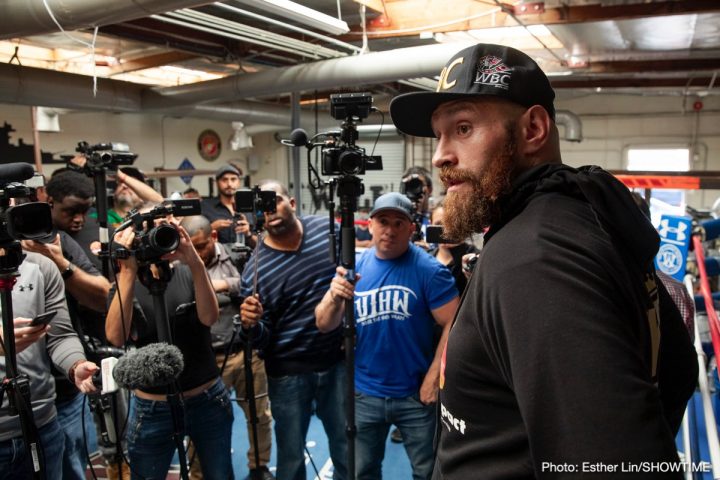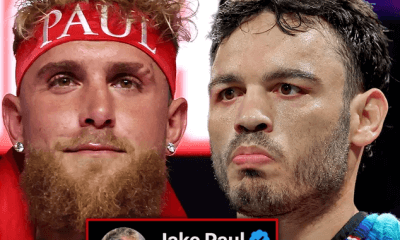Featured Articles
Tyson Fury Must Hope to Avoid Same Pitfalls That Bedeviled His Namesake

It is eerily prophetic that when former boxer John Fury’s tiny son came into the world on Aug. 12, 1988, in Manchester, England, three months prematurely and weighing just one pound, the father nonetheless determined that he should be named Tyson Luke Fury, after then-heavyweight champion Mike Tyson.
The baby, who was hardly assured of surviving an expectedly difficult infancy, not only made it to adulthood, he sprouted into a veritable giant of a man at 6-foot-9 and 260-plus pounds. Even more stunning is the fact that Tyson “The Gypsy King” Fury became, like his famous namesake, heavyweight champion of the world, completing a circle of improbability the odds of which had to be Powerball Lottery-winning long.
His immense size alone separates Tyson Fury from that other Tyson, a much more compact fighter who topped out at 5-foot-10 and was at his best at an optimum fighting weight of 217 or so pounds. In terms of their boxing styles, the two Tysons are just as dissimilar, the hulking Fury a dancing bear of a man with decent but not particularly devastating punching power, in stark contrast to the magnificently muscled “Iron Mike,” who in his prime was arguably the hardest hitter in the history of the heavyweight division.
But it is other, less laudatory links between the two Tysons that have raised questions about whether the now-30-year-old Fury (27-0, 19 KOs) can survive a potential crisis of another sort when he challenges WBC heavyweight titlist Deontay Wilder (40-0, 39 KOs) in the Showtime Pay Per View main event Saturday night at the Staples Center in Los Angeles. Like that other Tyson, whose spectacular rise to the top of his profession was derailed by a host of physical, emotional, legal and societal issues, the comebacking Briton of Irish descent must demonstrate – if he can – that he has moved past the litany of problems that took down Mike Tyson, the youngest heavyweight champion ever at 20, well before the onetime Brooklyn bad boy’s mesmerizing promise should have reached its expiration date. Just as the baby Fury had a premature beginning, so too did the mid-30s Mike Tyson have a premature and disappointing ending to a career that was as spectacular in its flameout as was his too-brief reign as a regal successor to the legendary likes of Joe Louis and Muhammad Ali.
As of now, Mike Tyson, now 52, is not among the celebrities who have confirmed they will be at the Staples Center to witness what many are calling the most important heavyweight matchup since Lennox Lewis knocked out, yes, a severely diminished Tyson in eight one-sided rounds on June 8, 2002, in Memphis.
Tyson lost two of his final three bouts, shocking stoppages at the hands of Danny Williams and Kevin McBride, after the last vestiges of his former aura of invincibility were smashed to smithereens by Lewis. Quitting on his stool before the start of the seventh round against the relatively pedestrian McBride on June 8, 2005, Tyson wearily said, “I don’t have the stomach for this. I don’t have that ferocity. I’m not an animal anymore.”
An acknowledgment of depleted commitment to a sport that demands total dedication was particularly noteworthy coming as it did from Tyson, the snarling beast of yore who, before his watershed, one-round destruction of Michael Spinks on June 27, 1988, in Atlantic City had boasted, “I’ll break Spinks. I’ll break them all. When I fight someone, I want to break his will. I want to take his manhood. I want to rip out his heart and show it to him.”
Such pronouncements of savage, violent domination are more common to knockout artist Wilder, too long and lean to be a physical prototype to Tyson, than to Fury, but the expressions of supreme confidence are more or less the same. Fury has had only two fights over the last three years, a fourth-round stoppage of the relatively unknown and much smaller Sefer Sefari on June 9 of this year and a 10-round decision over the somewhat more formidable Francesco Pianeta on Aug. 18, but to hear him tell it he is as good if not better than he was in his career-defining victory, a unanimous-decision dethronement of long-reigning champion Wladimir Klitschko on Nov. 28, 2015.
“I will stand and prove what I’m going to do to this idiot (Wilder),” Fury said at the London stop of a three-city, two-country media tour to hype the event. “I will punch his face right in for him. Not a problem. Seven days a week and twice on Sunday. If we fought 30 times, I’d win 30 times. That’s how confident I am of beating Deontay Wilder.”
And this, in New York: “He’s a big swinger. OK, he’s knocked a few bums out. He’s had 40 fights and 35 of them have been against total tomato cans who can’t fight back. If he thinks he can land one of those big swinging windmills on my chin, he should think again. After he feels a bit of power and a few stiff jabs in the face, his ass is going to fall out. Around (rounds) eight, nine, 10, welcome to my world. How am I going to let this little, skinny spaghetti hoot beat me?”
There are those who are convinced that Fury’s impressive mobility for such a large man, coupled with the height and heft that has enabled him to wear down opponents by putting his weight on them in strength-sapping clinches, will enable him to flummox the favored Wilder, as he had Klitschko. After that fight in Dusseldorf, Germany, future Hall of Famer Klitschko – who landed just 52 of 231 punches, a puny average of 4.3 per round (and an incredibly low 1.5 power shots), was almost sheepish in saying that “I couldn’t find the right distance to land those shots. Tyson was quick with his hands and his body movement and his head movement. I couldn’t land the right punches.”
But instead of capitalizing on his sudden notoriety and acclaim, Fury appeared to have a mental meltdown that very publicly dragged on for over two years. Not only did he go on an epic cocaine binge and ballooned to nearly 400 pounds (“I got fat as a pig,” he admitted), but he rattled off a series of politically incorrect statements that smacked of sexism (“I believe a woman’s best place is in the kitchen and on her back”), LGBT bias (“It’s like you’re a freak of nature if you’re normal”) and anti-Semitism (“I won’t be brainwashed by all the Zionist, Jewish people who own all the banks, all the papers, all the TV stations”).
All those missteps were reminiscent of the Mike Tyson who, after having amassed the kind of fortune and fame most fighters can only dream of, lost everything, or close to it, in a downward spiral of self-destruction. That Tyson did two prison stretches, one for rape, consumed copious amounts of cocaine and alcohol, and gorged his way to nearly 300 pounds, which is as unsightly on a 5-foot-10 guy as 400 pounds are on a 6-9 guy. He was fined and suspended by various commissions and sanctioning bodies, and left without a title after the second of his two heavyweight championship reigns ended on an 11th-round stoppage by Evander Holyfield on Nov. 9, 1996. The Mike Tyson of our memories was terrific for a time, but not as terrific as he could have been, and maybe should have been.
It remains to be seen if a victorious Wilder, as a heavyweight with aspirations of greatness, is a reasonable replication of the vintage Tyson – or of Holyfield or Lewis, for that matter – but it’s highly likely that Fury can at least temporarily reclaim much of what he frittered away should he pull off the upset against the Tuscaloosa, Ala., resident with the crushing overhand right that thus far has paid such major dividends. While lost in a stupor of drugs and gluttony, he was first stripped of his IBF title for agreeing to a rematch with Klitschko instead of facing IBF mandatory challenger Vyacheslav Glazkov. A bit further down the line he twice tested positive for cocaine, leading to a pair of postponements for the second Klitscho fight that never came off, resulting in his voluntary relinquishment of his WBA, WBO and IBO titles before those organizations could also strip him. His long period of inactivity also led to his being stripped of his lineal and The Ring magazine championships.
To his credit, Fury has sought and received treatment, as did Mike Tyson, from mental health professionals who understand that the line separating preening egomaniacs and manic depressives is thin and easily crossed, depending on circumstances. Although they come from decidedly different worlds, the prejudices and rejection both men faced while growing up shaped them in ways that no amount of success inside the ropes could permanently alter.
For Mike Tyson, much of who he was, is and forever shall be is the result of his upbringing in the blighted Brownsville section of Brooklyn, N.Y., where the poor black child with the lisp found himself an object of derision, finding a measure of solace only in his membership with a street gang, the Jolly Stompers, that hewed to the proposition that if its members couldn’t afford to get what they wanted, it was better to take it by force than to do without. It was a lifestyle that frequently landed Tyson in juvenile hall until boxing offered him a reprieve that never fully removed him from his roots.
Fury’s Jolly Stompers equivalent is his heritage as an Irish Traveller, some 40,000 nomadic people in the United Kingdom and Ireland who never stay long in any one place, moving about as tightly knit caravan communities. But wherever they go, the Travellers are apt to find hostility and hatred. Even after his defeat of Klitschko, Fury was reminded of the taint he presumably bears and might never be able to completely erase. Denied service at a UK restaurant for himself, wife Paris and their three children, Fury complained that “I’m the heavyweight champion of the world and I’ve been told, `Sorry, mate, you can’t come in. No Travellers allowed.”
Whether Mike Tyson is in the Staples Center audience on Saturday night remains to be seen, but he has weighed in on the bout and seemingly is leaning toward the “Gypsy King.”
“Although Wilder’s punch is strong, nothing can compare to the mental strength Fury has shown both in and out of the ring,” Tyson said. “It’ll be a close call, but I think Fury’s got a true fighting chance.”
Check out more boxing news on video at The Boxing Channel
-

 Featured Articles4 weeks ago
Featured Articles4 weeks agoAvila Perspective, Chap. 330: Matchroom in New York plus the Latest on Canelo-Crawford
-

 Featured Articles3 weeks ago
Featured Articles3 weeks agoVito Mielnicki Jr Whitewashes Kamil Gardzielik Before the Home Folks in Newark
-

 Featured Articles16 hours ago
Featured Articles16 hours agoResults and Recaps from New York Where Taylor Edged Serrano Once Again
-

 Featured Articles4 weeks ago
Featured Articles4 weeks agoCatching Up with Clay Moyle Who Talks About His Massive Collection of Boxing Books
-

 Featured Articles5 days ago
Featured Articles5 days agoFrom a Sympathetic Figure to a Pariah: The Travails of Julio Cesar Chavez Jr
-

 Featured Articles3 weeks ago
Featured Articles3 weeks agoMore Medals for Hawaii’s Patricio Family at the USA Boxing Summer Festival
-

 Featured Articles7 days ago
Featured Articles7 days agoCatterall vs Eubank Ends Prematurely; Catterall Wins a Technical Decision
-

 Featured Articles4 weeks ago
Featured Articles4 weeks agoRichardson Hitchins Batters and Stops George Kambosos at Madison Square Garden




















